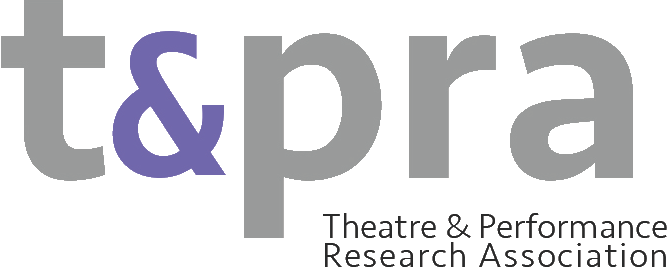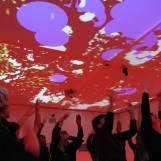Full Name: Joanne Scott
Annual Conference Theme (if applicable): Inclusive Intermedialities?: engagement, interaction and discomfort in technologically enabled performance practices
What were the main points that emerged from your WG this year?
This year, there were strong strands running through our working group presentations and discussions centred on ideas of inclusion and access, as enabled and disrupted by new technologies employed in the making and presentation of performance. There was also a focus on the sometimes uncomfortable intersections between human and machine, particularly the ways in which a form of shapeshifting can happen between human and non-human processes and the types of failure involved in human machine interactions.
This was taken up firstly by Katie Hawthorne’s presentation dealing with different forms of ‘humanoid performance’ and technologies that perform a kind of humanness. Through three examples, different relations between technological systems and processes and broad notions of humanness were explored, as well as the significance of present and online audiences to these works. This thread was also developed through Vlad Butucea’s discussion of the open world computer game, ‘Everything’, which allows the player to inhabit and act as various different matters, agencies and non-human beings, as part of the game-play. The exploration of the relations between things – an ecology of agencies and happenings – was identified in the work, as well as a de-centring of the human in the game environment, with the player ‘becoming minor’ through their explorations of margins. In the final presentation, Jo Scott explored wildness in nature and the digital, particularly through a set of processes for revealing digital processes in representations of a wild, green space captured on a mobile device. Discussion centred on notions of humanity as what we are willing to bestow on other beings and entities, the leakiness/messiness and fallibility of bodies and how this enters into digital spaces, as well as some thoughts on modes of digital fakery and obfuscation.
Our second panel included two presentations that focused on different intersections of the virtual and actual in artistic practice. Qiangxiong Yang explored the cinematic quality of mapped projections onto exterior architectural facades, as well as projection in interior installations. Processes of actualisation, surfaces becoming virtualised and some of the disrupted relations between interior and exterior were discussed. This was interestingly echoed in Piotr Woycicki’s presentation exploring the AR documentation he has created of an intermedial performance ‘Our Lady of the Shadows’. Here again, notions of spatial continuity between inside and outside were presented and the zones of indistinction formed through AR practices, as well as a navigation of virtual and actual on the part of the user/viewer. These presentations led onto discussions about the functioning of the interface and the different ways in which surfaces happen and manifest in these practices.
Session 3 began with a presentation by Kasia Senyzyn, outlining her research into a range of resources and methods to make theatre more accessible and the work she has been doing advising companies and venues, particularly in terms of scaling such resources accordingly. The strategies introduced, which ranged in technological complexity, highlighted a range of possibilities for increasing accessibility to information about the performance, the space and the performance experience itself. Following this, Pascale Aebischer considered ‘bleeding edge technology’ in the RSC’s 2016 production of
The Tempest, particularly the ‘excess of presence’ generated through the simultaneous appearance of the performer playing Ariel and their digital avatar and the effect of experiencing this technology ‘under stress’ due to the demands the piece placed on the system.
Our open panel included a performance of Dan Herbert’s interactive algorithmic poetry piece, which was followed by a presentation by Dan, outlining the project associated with the performance and some of the processes of making and presenting, including the particular intersection of human and machine interactions that constitutes this work. John D’Arcy then offered a presentation reflecting on a range of interactive sonic works that he has researched and created, particularly focused on ‘Do You Hear What I Hear?’ an interdisciplinary project exploring how differences in auditory sensory experiences can be shared through technologically assisted performance practices. Some members of the group also got to experience this platform in small groups prior to the panel. Discussions ensued around processes of simulation, the positioning of audiences in these two experiences and what their different systems/interfaces enable.
The final panel began with a presentation by Anka Makrzanowska, exploring the embodiment of disappearance in a concert-installation titled ‘A Gig A Byte’. This large scale event was discussed in terms of the types of (trans)presence and (trans)locational states it prompted on the part of the visiting audience members, engaging a mode of ‘cyberparticipation’ and synergies between live and mediated modes pf presence. Manoli Moriaty then presented his project in polydisciplinary collaborative practice in performance, focusing on a framework he has developed for interpreting the biological and evolutionary notion of symbiosis to the understanding and practice of collaboration between different disciplines in performance. The final presentation, by David Houston Jones, addressed the work of John Gerrard’s
Exercise (Djibouti) in relation to Beckett’s
Quad, particularly focusing on the simulation of human movement in the former in relation to the system of the latter and the disappearance of the human into the permutations of that system. Non-human forms of viewing and attention were addressed in the perspective Gerrard’s work offers and following this presentation, the notion of the obfuscation or disappearance of the human into the systems explored in all three presentations was discussed, as well as the different ‘programming’ or instructions that lead each system of performance. Again, the working group discussions turned to the excess of the material body in such modes of performance, along with notions of failure as they exist in this excess and its intersection with algorithmic and coded systems.
What was discussed at your business meeting?
(1) Jo Scott (JS) and Christina Papagiannouli (CP) welcomed Piotr Woycicki (PW) as a new convenor
(2) JS announced that she would be stepping down as convenor, after 3 years. Before this, JS is planning to hold an interim event at the University of Salford in Spring 2020, with the working theme of ‘hacking and glitching’. CP announced that she would stay on for one more year to stagger the introduction of new convenors and to support PW
(3) The convenors summarised some of the key themes from this conference and CP reminded the group about the affiliated issue of the International Journal of Performance Arts and Digital Media, which will reflect on the last two conference sessions and interim event for the working group. The title of the issue is ‘Inclusive Intermedialities’ and the call for this will be released following the conference. WG members were encouraged to submit papers or alternative documents.
(4) CP also shared discussions with Bloomsbury/Methuen about an edited collection of essays emerging from the work of the group
Types of contributions:
Paper presentations, provocations and performances
Number of formal contributors (those listed in book of abstracts) 12
Approx. overall number of delegates who attended your WG Sessions 18-20
Composition of WG (PG, ECR, etc.)
The Performance and New Technologies WG members are from all career levels. In 2019, the WG presenters were comprised of four PGRs, four ECRs and four mid-career and senior researchers. One of the WG members presented as part of TaPRA Gallery sessions. Due to missing registration, 2 of the contributors did not manage to attend the conference.
Did you have any non-UK participants? Yes
If your WG hosted an Open Panel, do you have any feedback?
We were able to stage a performance as part of our open panel and this was really effectively facilitated by the tech team at Exeter, who made that possible. The intersection of live practice and discussion is one that is very productive for this working group.
Any additional points or feedback not covered above?

